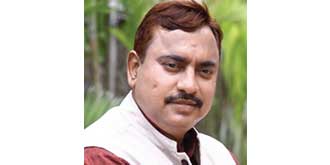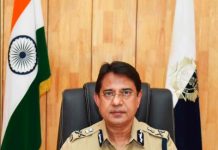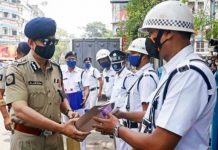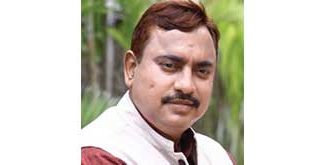Sherlock Homes, Feluda, Kiriti Roy and many others like them are not imaginary characters created by the authors. Even it is not that they are sketched just to create an impression about the detectives or to make the most entertaining thriller movies. But the detectives are very much around us whom we hardly notice.
Familiar Feluda and other private detectives used to help the police for detecting important cases. However, in real situation detectives in the police department perform similar acts to crack, track and control crimes. The Detective Department (DD) of Kolkata Police not only detects crime but also creates a situation for the habitual criminals who think twice before committing any crime. This is how Kolkata Police ensures safety and security for its residents, visitors and tourists.
Collecting true and authentic information is the key to detecting crimes and solving cases. Kolkata Police had felt the need for setting up a separate wing way back in 1868 on 28 November to investigate an unnatural death in Amherst Street area which had raised huge public outcry around that time.
The department was set up primarily to investigate that special case when Sir Stuart Hogg was Commissioner of Police who appointed Inspector A.Younan to take charge of the department, which has since then contributed positively in extending support in the functioning of Kolkata Police. There was no looking back for the department. Rather its activities went on increasing with the changes in the socio- economic and cultural scenario in this evergrowing cosmopolitan city. Detective Department has grown in scale over the years and plays a very crucial role in solving various criminal cases. Because of its expanding activities in different sectors, the DD has been divided into different sections, each focusing on a particular type of crime.
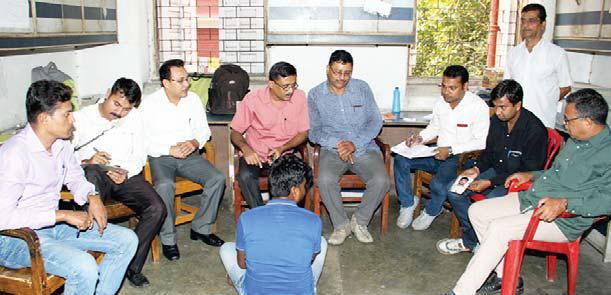
Evolution
By virtue of recommendations of Patton Committee appointed in 1845, the Commissionerate system in the lines of London Police was introduced in Calcutta on November 1, 1856 when the then Chief Magistrate, Sir Samuel Wauchope became rst Commissioner of Police. But the recommendation for a detective force in Calcutta was disapproved by the Governor of Bengal. The seeds of an idea had however been sown and bore fruit two decades later following a gruesome murder of a young lady in Amherst Street on April 1, 1868.Sir Stuart Hogg, the then Commissioner of Police issued Circular No 149 on November 28, 1868 by which he set up a Detective Force in Calcutta police with Mr. A Younan as its Superintendent. In reducing its strength in 1873, Sir Hogg transferred Superintendent Younan and put in charge Inspector Richard Reid who solved the Amherst Street case. Detective force under Stuart Hogg worked satisfactorily in conjunction with regular police. But in early 1870s, Mr. Wauchope was brought back in Calcutta police for the second term in place of Sir Stuart Hogg. Mr. Wauchope abolished the Detective Force. He however kept his chosen men for detective purposes under his personal direction. At the close of second term of Mr. Wauchope in 1873, Sir Hoggre turned to Commissionership.
In 1876, Inspector Richard Reid was promoted to ofciate as the Superintendent of both Detective Force and Reserve Force. In 1879, the unit was divided into two establishments – one at Lalbazar with Reid and the other at 34, Sooterkin Lane with inspectors Sree Nath Pal and Kisto Chunder Banerjee. In November 1884, the premises at 34, Sooterkin Lane were vacated and a portion of the building at 5, Halliday Street was occupied by the detectives. Later the detective office was set up at Kenderdine Lane before it was nally shifted to Lalbazar.
It was in 1898 when Jogendra Chandar Mitra headed the detectives as the rst Indian. He was succeeded by Kisto Chunder Banerjee. By 1908 Detective department came to be known as the Criminal Investigation Department on the pattern of Bengal Police. But 1910 onwards the department came to be known by its old name. A separate and independent cell was set up in 1908 to collect political intelligence and to deal with the militant nationalists. Between 1906 and 1916 Sir Charles Tegart remained in charge of both detective department and city criminal investigating department.
Following the partition of Bengal and formation of different revolutionary groups, there raised a need for a separate department in Calcutta Police. A surveillance scheme was prepared in 1911 and at the initiatives of Sir F L Halliday, Commissioner of Police and Sir Charles Tegart, a separate department called Special Branch, with a Deputy Commissioner of police and sufcient staff, was created.
In 1916, Mr. L N Bird became the rst Deputy Commissioner of Police of the Detective Department and remained for almost a decade in the ofce. In 1918, the post of Superintendent was upgraded to Assistant Commissioner and J Malcahy assumed charge as rst Assistant Commissioner of Police in the department. In view of increase of robbery cases as well as Goonda activities in 1920, Special Goonda Department was created. Besides supervision of all robbery cases, Goondas were grouped according to their gangs and area of operation and surveillance was also maintained. This may be called the precursor of the present Anti Rowdy Squad.
In May 1940, Mr. Hirendra Nath Sirkar took over the charge of the ofce of the Deputy Commissioner of Police, Detective Department as the rst Indian DC and he introduced the Atcherly’s 10-point analysis of the mode of operation of criminals. In March 1948, one post of Assistant Commissioner of Police and a few subordinate posts were sanctioned for the Criminal Intelligence Section. Shri Chandra Sekhar Burman was the rst Assistant Commissioner of this section.
Pursuant to the recommendations of Hazra Committee, rst overhauling of the entire organization including Detective Department was done in 1951. Strength of Detective Department was then considerably raised. Meantime, the Special Goonda Department was replaced by an Anti Rowdy Squad in the Enforcement Branch which came into being just before the World War. In 1964, the squad came under the control of Detective Department to tackle the serious communal riots in the city. This squad presently deals with all anti-social activities including gambling, rowdyism, extortion, ransom, abduction etc. Similarly, the Missing Persons Squad, earlier a part of Enforcement Branch also started functioning since 1970 in this department. This squad not only tries to locate all missing persons but also keeps track of all unidentied dead bodies.
In June 1966, the post of Additional Deputy Commissioner of Police was sanctioned by the government. The legendary Shri Debi Prasad Ray was the rst officer to hold this post on promotion. Subsequently this post was redesigned as DC II, DD.
With the extremist violence rocking the city in 1969-70, Bomb Squad was created in the Department in November 1970. This squad has now adapted to the task of detection and in vestigation of suspected different types of bombs and other explosives keeping in tune with the fast changing scenario of extremist activities and their operations. The Bomb Disposal Squad which was set up in the later part of 1993 deals with detection, removal and disposal of explosives. With the increased use of high explosives, this squad is now equipped with various specialized equipment.
Detective department is housed in a building at the western side of the compound at Lalbazaar, the Headquarters of the Kolkata Police. The DD Building was nally completed in 1929 and had been utilising the site of the present Central Lock-up since 1918. This building was initially used as the quarters for married European Inspectors and Sergeants. Now this building is occupied by the Detective Department with its expansion in the form of various sections, squads, cells and wings.
At present, the Joint Commissioner of Police (Crime) is the Head of the Department and is assisted by Deputy Commissioner, DD (II) and Deputy Commissioner, DD (Special). It is a specialized unit and investigates important cases, collects criminal intelligence, studies the crime pattern of the city, initiates and monitors preventive steps and follows up criminal trials. The department has meticulously investigated several complicated cases and solved them.
There are 33 units with specic responsibilities working under this department. It consists of a number of sections including Homicide Squad, Anti-Dacoity and Robbery Squad, Anti- Burglary Squad, Anti-Snatching Squad, Watch Section, Anti- Motor Theft Section, Immoral T rafficking Section, Anti – Cheating Section, Anti-Fraud Section, Special Cell, Bomb Squad, Missing Persons Squad, Women Grievance Cell, Narcotic Cell, Anti-Bank Fraud, Anti- Rowdy Squad and Wildlife and Environmental Wing each focusing on a particular type of crime. In effect this department has become the most important arm of the city police force providing security cover for different types of situation, which is becoming multifarious in nature.
Apart from those major sections, there are also supportive sections like – Criminal Records Section, Bomb Disposal Squad, Scientific Wing, Dog Squad, Finger and Footprint Squad, Photography Section and Plan Making Section. All these sections provide security net to the city as well as help in finding clue and detecting crimes like murder, robbery- dacoity, bomb – land mine blastetc. Police personnel working under its umbrella work round the clock to keep the city life peaceful.

Homicide Squad
Established on 28 November 1868, Homicide Squad deals with the homicidal cases and unnatural death cases other than road trafc accidents in the city. Homicide Squad itself investigates the most important and sensational cases of the city. Due to their highly efficient investigation abilities, the officers of Homicide Squad receive appreciation not only from the Judiciary but also from the Press and general members of the public. Some of the important cases investigated by the Homicide Squad which ended in conviction were reported to All India Reporter – Supreme Court Cases. Acquittal of the accused persons from the cases investigated by Homicide Squad is a rarity.
Anti-Dacoity and Robbery Squad
Anti – Dacoity and Robbery Squad has been functioning since the inception of the Detective Department in 1868. The section performs multifarious jobs apart from its main objective of prevention and detection of dacoity and robbery in the city and ensuring justice to the victims of the crimes by achieving conviction. The section maintains sources, continuously monitors old and jail out criminals and their families and associates as well. Intelligence regarding habitual receivers is collected by this section. Also regular raids are conducted by this section in the criminal hideouts.
Anti-Burglary Squad
Operating since formation of the Detective Department in 1868, Anti-Burglary Squad deals with the crimes like house or shop theft, unauthorised trespassing at day or night for the purpose of theft, theft by domestic servants and the employees, and criminal breach of trust by them. The section mainly uses the methods of detection – study the modus operandi, preservation of foot and nger prints, technical operation like examination of mobile phones, tracking of mobile phone numbers, footages of CCTV cameras, utilisation of Portrait Parle and utilisation of source network.
Anti-Snatching Squad
Anti-Snatching Squad is also in operation since the formation of the Detective Department and deals with various types of modus operandi of snatching. Common types of snatching are on foot, with the help of a motorcycle, from bus, taxi, or an auto rickshaw. Personnel of this squad collect intelligence inputs from their regular sources about the activities of various gangs who operate in the city. They are keeping watch on the activities particularly on the criminal gangs from Uttar Pradesh, Kalyan, Mahi, Kurla from Maharashtra and Motihari from Bihar.

Watch Section
Functioning since 1950, the personnel of Watch Section are mainly assigned to prevent and detect crimes like pocket picking, bag cutting, lifting articles in different markets, public transport, banks, fairs, exhibitions and other public places. Initially, this section undertake parallel investigation in such cases recorded by the police station and tried to nd out the miscreants involved with a view to recover the stolen properties. As soon as the miscreants were located, the section took full control of the cases for investigation.
Anti-Motor Theft Section
Out of several sections of the Detective Department, Anti- Motor Theft Section is entrusted with the prevention and detection of motor-vehicle theft in the city. It maintains an updated criminal database and maintains liaison with NCRB ( National Crime Records Bureau), SCRB (State Crime Records Bureau), State FSL (Forensic Science Laboratory), C F S L ( F o r e n s i c S c i e n c e Laboratory), RTOs (Regional Transport Ofces) and other agencies for detection of motor theft cases. The section also assists the ofcers of police stations in detecting such cases. Further, for the purpose of quick a s s i m i l a t i o n o f i m p o r t a n t information, a close link is m a i n t a i n e d w i t h t h e B S F authorities posted in the Indo- Bangladesh border of the North 24 Parganas district.
Immoral Trafcking Section
The Immoral Trafcking Section specially deals in combating sexual exploitation of women and children in the form of t r a f c k i n g f o r c o m m e r c i a l purposes. This cell also keeps a close watch on trafcking of minor girls and women for the prostitution. It works hand in hand with NGOs for recovery and rehabilitation of trafcked victims. Besides, this section o r g a n i s e s a w a r e n e s s a n d sensitization programmes the public.
Anti-Cheating Section
Formed in the British Era, this A n t i – c h e a t i n g s e c t i o n w a s formed with a view to provide relief to the people of Kolkata from cases of exploitation of f u n d s , e m b e z z l e m e n t , a n d cheating. This Section deals with the cases of cheating, fraud, criminal misappropriation of funds, criminal breach of trust, falsication of accounts and cases which are indexed under the Prevention of Corruption Act, 1988. Complaints in respect to cheating in the form of employment, chain business and facilitation of loans are also dealt with by this section.

Anti-Fraud Section
The Anti – Fraud Section is specialised in dealing with white collar offences pertaining to cheating, impersonation, forgery, falsication of accounts, etc. This section records and investigates cases under the penal section of 120B, 419, 420, 467, 468, 471, 477A IPC under Prevention of Corruption Act, 1988. Fraud cases, where public money or Govt. exchequers are involved, are investigated by this section. A large number of sensational cases like Kolkata Police constable recruitment scam, Monozyme Blood Test Kit scam, impersonation in Joint Entrance/SSC Examinations etc. have recently been successfully investigated by this section.
The Anti-Fraud Section also investigates cases pertaining to home loans; cash credit loans, sanctioned through forged documents. Cases of forgery by errant businessmen in connivance with bank officials, using counterfeit credit cards, and unlawful activities on behalf of collection agents appointed by the banks causing annoyance to the bonafide customers are also being looked after by the section. Cases pertaining to medical negligence by doctors, hospitals, nursing homes, etc. are also looked into.
Bomb Squad
With the extremist violence rocking the country, a separate unit called Bomb Squad was created in November, 1970. The squad deals with collection of information regarding illegal p o s s e s s i o n o f a r m s , ammunitions, and explosives. Seizure of sound crackers is also carried out, especially before Durga Puja and Kali Puja, keeping in tune with the fact of changing crime scenario.
Missing Persons Squad
Missing Persons Squad (MPS) in the Detective Department at Lalbazar works centrally for all the Police Stations. Generally the
rst information of a missing person is not acknowledged directly in the office of MPS. The same is accepted at the respective police station of the area where the missing subject was last seen.
On receipt of information of a person reported to have been missing, the same is endorsed to an ofcer of MPS for follow up action. The ofcer performs the required formalities for wide circulation throughout the state besides carry out inquiry for seven years towards tracing out of the missing subject.
Women Grievance Cell
With changing scenario, Kolkata Police felt the need to set up a special cell for redressing the grievances of women. Women G r i e v a n c e C e l l u n d e r t h e Detective Department has been functioning since 1988 to combat crime against women. Women Grievance Cell monitors and supervises the investigation for the cases like Dowry Death (under section 304B of IPC), Abetment to commit suicide (under section 306 IPC), Rape (under section 376 of IPC and POCSO Act), Torture against wives (under section 498A IPC), Molestation (under section 354 of IPC), Eve Teasing (under section 509 of IPC) and others cases related to women. Sometimes aged persons particularly women are physically and mentally tortured by their son/daughter-in-law as to grab their property. Such complaints are also addressed by Women Grievance Cell.
T h i s C e l l h e l p s w o m e n t o r e c o r d complaints and cases and also takes action for proper investigation. It also monitors d i f f e r e n t c a s e s r e l a t e d t o w o m e n registered with the police stations of all divisions. The aggrieved women are provided with necessary assistance to contact Protection Ofcer for getting relief within a short period. Women Grievance Cell plays a key role in getting such assistance.
Narcotic Cell
The Narcotic Cell is one of the most important sections of Kolkata Police and its primary aim is to ensure public welfare and guard against danger to the public health. The ofcers of Narcotic Cell engage sources for keeping a bird’s eye in the different Night Clubs, Discos and Pubs in and around the city of Kolkata. Regular clandestine visits are being made to those places and after the ofcials manage to earn the trust of the drug dealers, they are nabbed.
The Narcotic Cell tries to plug the supply c h a i n o f D r u g s a n d P s y c h o t r o p i c substances and carry out campaigns and workshops in educational institutions and local clubs of the city. It also observes International Day against Drug Abuse and Illicit Trafcking. It conducts extensive campaigns and workshops in various Schools and Colleges and students, teachers and guardians of those institutions made aware of the ill effects and fatal consequences of the Narcotic Drugs. Detoxication Camps are also opened in association with the NGOs where free medical treatments are being provided to the poor and destitute addicts.
Anti-Bank Fraud Section
Anti-Bank Fraud Section has been functioning since 5 August, 2005 in accordance with the concurrence from the Government of West Bengal. This section records cases on their own and takes up important cases from police stations with due approval from Jt. CP (Crime) relating to cheating, forgery, criminal conspiracy, criminal breach of trust, etc. where mostly banks and their customers are the victims and where loss of public money occurs.
Anti-Rowdy Section
Anti-Rowdy Section (ARS) was initially under the control of the Deputy Commissioner (Enforcement Branch), but subsequently it was transferred to the Detective Department in 1994. The section collects intelligence reports about the activities of rebrands and registers roughs and also those roughs in the making, prevents rowdy activities, extortion, detects kidnapping cases specially those for ransom. Apart from these, the section also prevents gambling, collect intelligence inputs about illicit distillation of liquor, making enquiries relating to companies to law and order problem that hampers tranquility.
Wildlife and Environment Offences Wing
Created in 2005, the Wildlife and Environment Offences Wing c o m b a t s o r g a n i s e d c r i m e s relating to trade in wildlife, thus protecting endangered species and wildlife. This section also renders active assistance to the State Pollution Control Board in implementing the provisions of the Environment Protection Act.
Bomb Disposal Squad
Created in 1993, the Bomb Disposal Squad (BDS) deals in detection, removal and disposal of explosives. With the increase u s e o f h i g h m a g n i t u d e explosives by terrorists, BDS is n o w e q u i p p e d w i t h m a n y specialized equipments for handling such objects. The personnel are specially trained for this purpose.
 Scientic Wing
Scientic Wing
Footprint and Figerprint Section has of late evolved into Scientic Investigation Wing of Kolkata Police. Footprint and Fingerprint Section collects footprint and ngerprint of the alleged accused and habitual criminals for keeping records and evidences. This wing also incorporates the Photography a n d P l a n M a k i n g S e c t i o n . Photography Section captures various photographs from place of occurrence of crime and Plan Making Section makes the drawing for reconstruction of the incident viz. how the crime is committed. Scientic Wing is being equipped with various specialized gadgets like lie detector which is very helpful for investigating unusual crimes.
Cyber Police Station
Cyber Police Station is now functioning as an independent police station since 24 August 2010. However it is an integral part of the Detective Department as Cyber Crime Cell had started functioning in 2005. This section, which is rst of its kind in the eastern part of the country, was formed in the wake of increased cyber crimes in the city. Cyber Police Station covers the area comprising all the 69 police stations of Kolkata Police and h a s j u r i s d i c t i o n r e l a t e d t o offences committed under the Information Technology Act 2000 with relevant provisions of the Indian Penal Code and other laws within the Kolkata Police area. The investigating team of Cyber Police Station is well equipped for handling different k i n d s o f C y b e r F o r e n s i c hardware and softwareand quite capable of analysing various seized digital evidences. T h e s e i z e d e x h i b i t w h i c h normally contains Hard Disks, Mobile phones, SIM Cards, Data Cards, Memory cards, etc. are sent to the Central Forensic Science Laboratory for forensic examination.
A Cyber Lab was set up in 2011 at Kolkata Police Headquarters in association with Data Security Council of India (DSCI), a self regulatory body of NASSCOM ( N a t i o n a l A s s o c i a t i o n o f S o f t w a r e a n d S e r v i c e s C o m p a n i e s ) f o r i m p a r t i n g training to the police personnel. T h e I n s p e c t o r s a n d S u b – Inspectors of different police s t a t i o n s o f K o l k a t a P o l i c e
undergo a ve-day basic training p r o g r a m m e r e g a r d i n g investigation of cyber crime cases. Apart from investigation, the ofcers of this PS take part in seminars at schools, colleges, science fairs, etc. to make people aware about cyber crimes and take preventive measures.
Dog Squad
The journey of Dog Squad in Kolkata Police began in 1971 when Scotland Yard gifted one German Shepherd dog to its Kolkatan counterpart. She was Pavlavo. Later, three dogs were inducted in the squad within a few years. However, Dog Squad was ofcially sanctioned with six d o g s i n 1 9 7 6 u n d e r t h e supervision of an Inspector. Dog S q u a d o f K o l k a t a P o l i c e u n d e r t a k e s b r e e d i n g programmes at regular intervals to ll up the vacancies. The dogs of KP Dog Squad are deputed for specialised tasks and are trained accordingly. The various tasks they do are crime tracking, explosive detection, search & rescue, guard & assault and narcotics detection. The dogs are trained at the National Training Centre for Dogs (NTCD) at the B S F T r a i n i n g A c a d e m y a t Tikampur, Gwalior, Madhya P r a d e s h . T h e c e n t r e i s supervised and run by the Ministry of Home Affairs.

